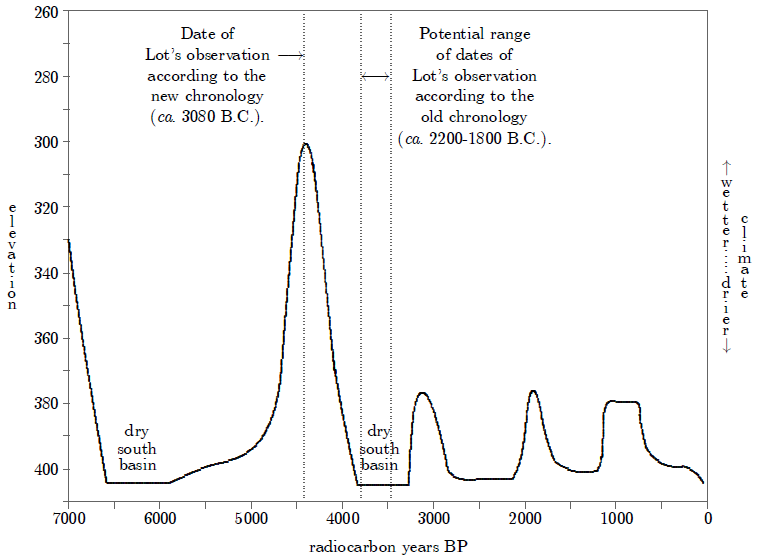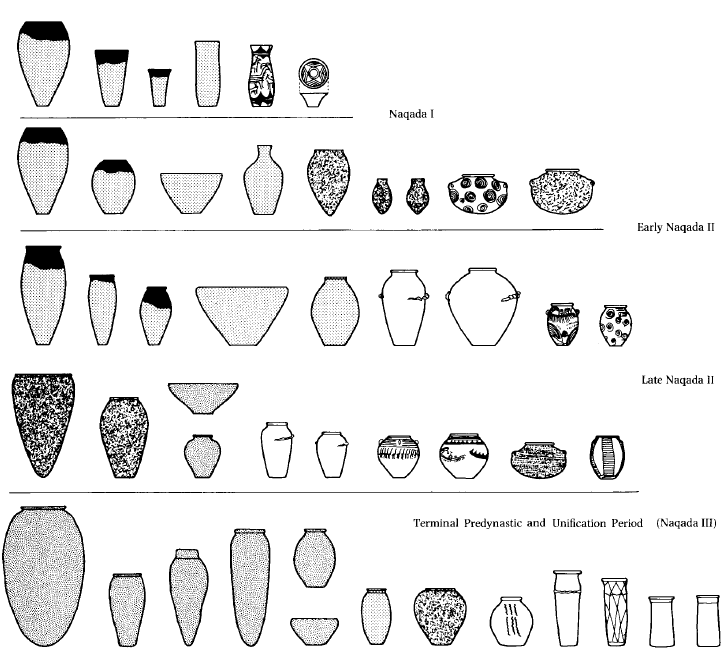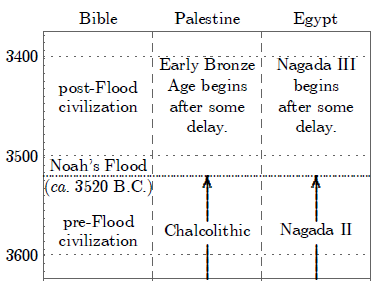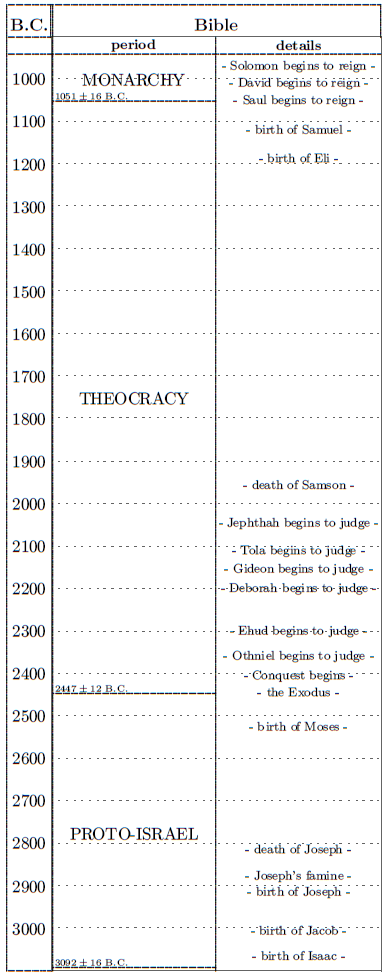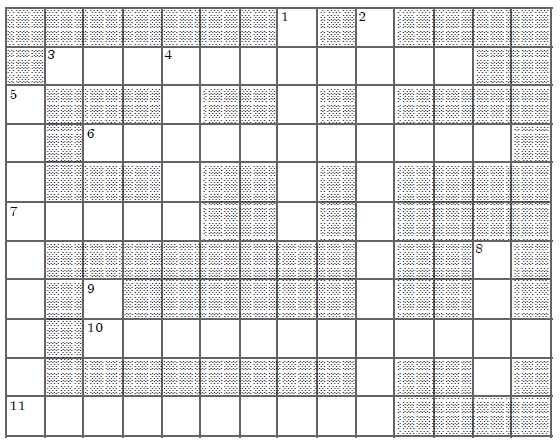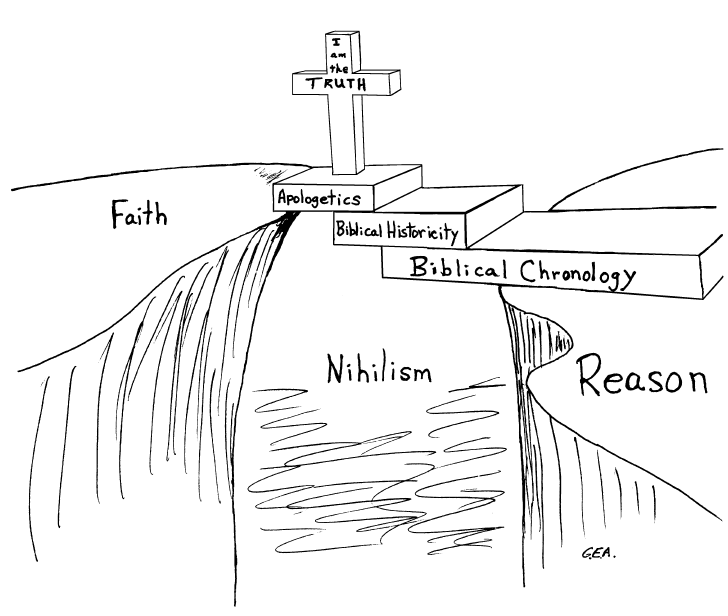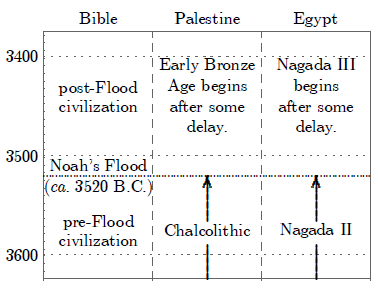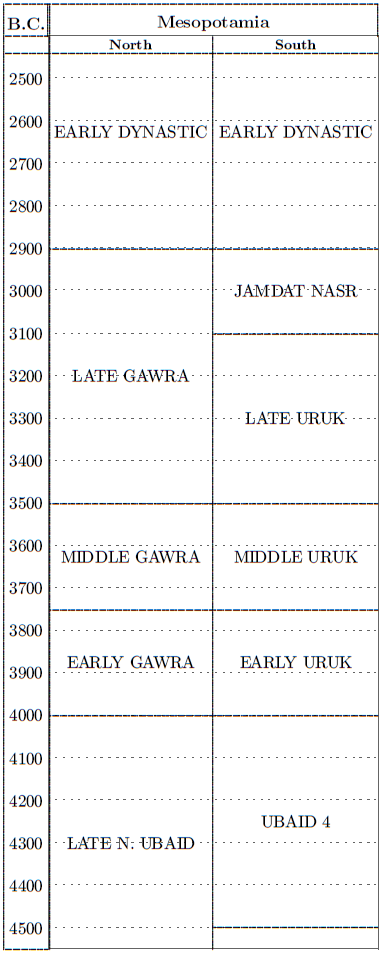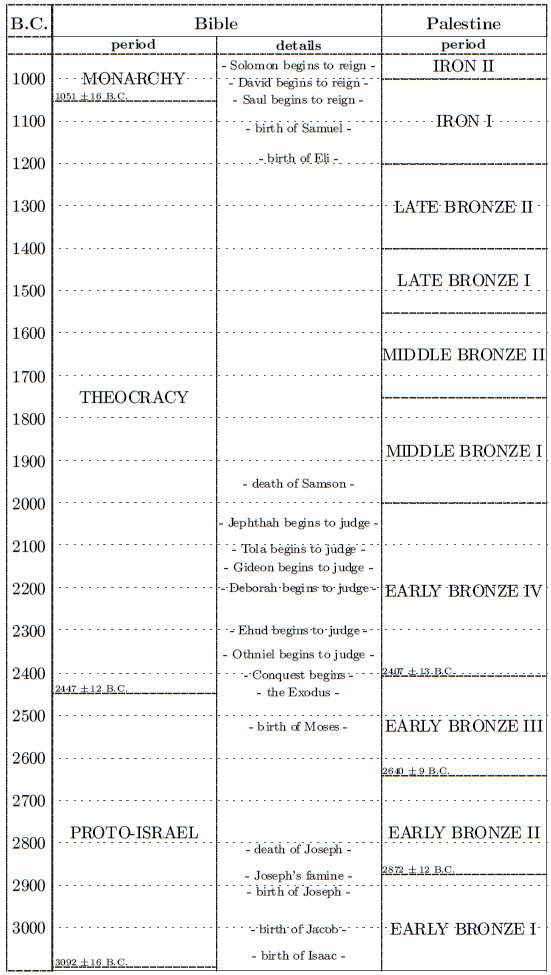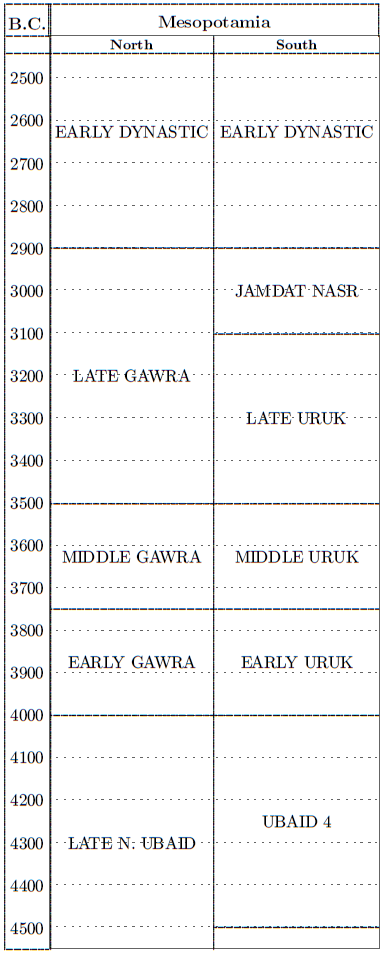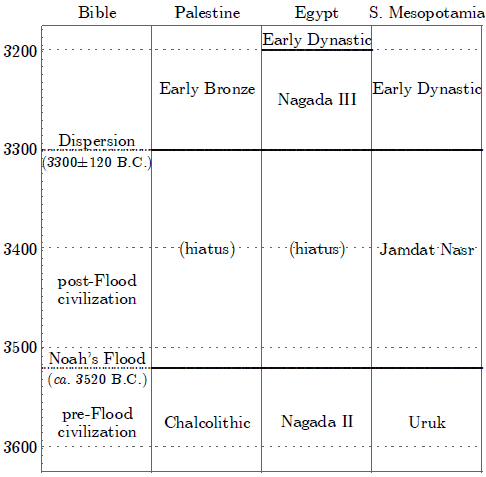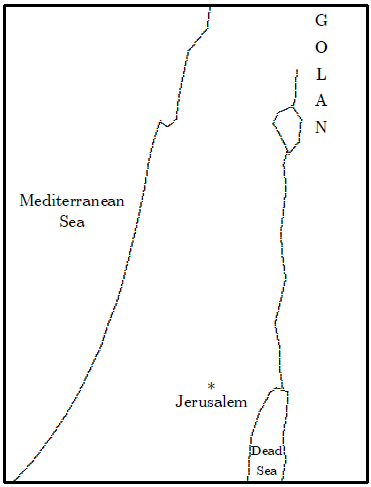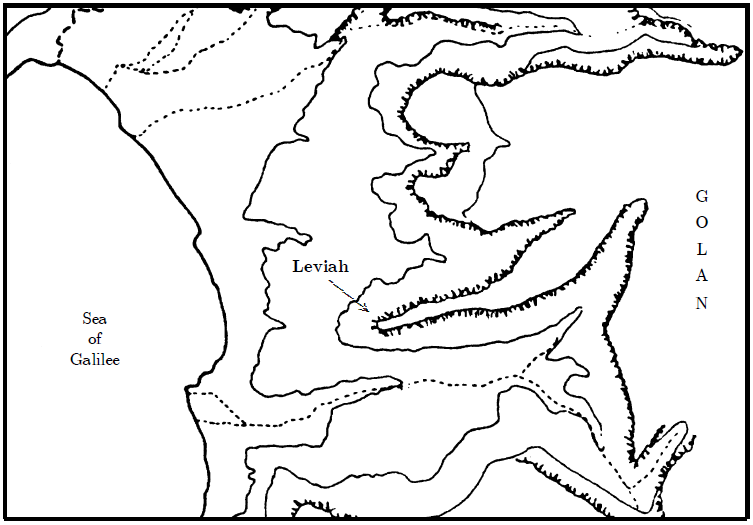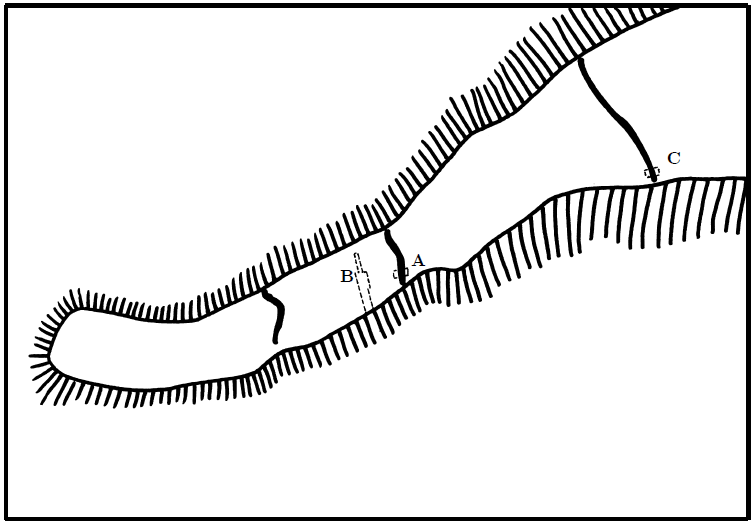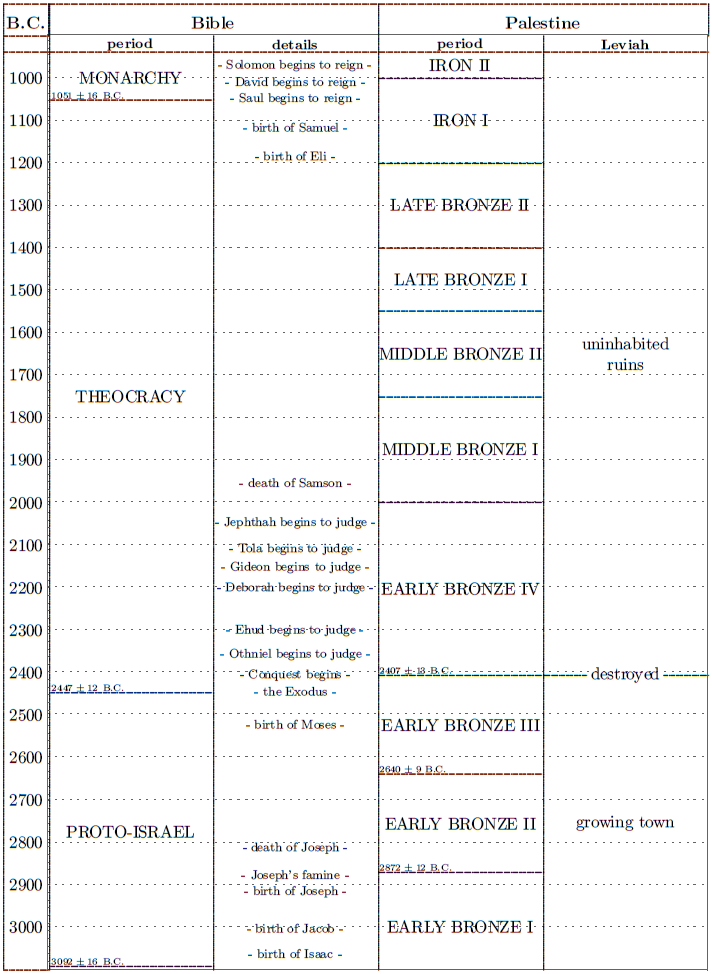 |
| Volume 1, Number 6 | November/December 1995 |
Yeroham—The True Mt. Sinai?
Well, research these past several weeks has been pretty exciting. I am reasonably confident that I have discovered, among other things: the location of the "Red Sea" crossing, where Pharaoh and his army were drowned as they pursued the fleeing Israelites at the time of the Exodus; and the true Mount Sinai, where the ten commandments were given to Israel.
I alluded to this most recent research thrust in my "Research in Progress" column last issue, and promised to keep you informed as appropriate. The new spate of discoveries which this research has resulted in is too large to condense into my "Research in Progress" column this issue, and of such importance as to demand headline coverage. Thus, I have decided to disclose these most recent findings in this lead article position.
I began to work on the problem of the route of the Exodus several months ago when I read a passing comment in the book The Archaeology of Ancient Israel[1] to the effect that mixed Egyptian and Early Bronze Age IV pottery shards had been found at a number of ancient campsites in the Sinai peninsula. I suspected immediately that these were campsites made by the Israelites as they left Egypt. (I will explain why below.) But I needed much more than just a passing comment to be able to pursue this matter—I needed original research publications. As it turned out, it was quite a process locating these in this case.
No specific references were given with the passing comment regarding these campsites in the book, and a day spent in the library checking hopeful references from the bibliography turned up nothing, as did a pretty exhaustive (and exhausting) search of available citation indexes and the like. Ultimately, I had to write to the professor who had made the comment to ask what sources he had worked from. He lives and works in Israel, so our communication took several weeks.
I didn't tell him I needed this information to find the route the Israelites had taken from Egypt to Palestine after the Exodus for fear he would think me a crackpot and not respond. This route has been the subject of much consternation and debate for decades, if not centuries. At the present time scholars are as likely as not to relegate the whole account of the Exodus to the realm of fiction. So I felt it prudent to keep my purpose to myself.
The professor kindly wrote back informing me that there was only a single paper which contained the information I sought. Unfortunately, it was written in Hebrew. As Hebrew is not one of the six languages with which I am conversant (these being English, FORTRAN, ASSEMBLER, BASIC, PASCAL, and C) I next had to find a translator.
Several weeks later I finally had an English version of the paper in my hands. A quick read through confirmed that I was on the right track—a further week and a half of intensive research and the basic routes had clarified.
As I now set about to communicate what I have found to you, my subscribers, at this earliest opportunity, I am a little daunted at the task of reducing it all to these few newsletter pages. I will obviously need to skip over many points and leave some important material out altogether in this initial communication. I trust you will make suitable allowance for this necessity as you read.
The Bible teaches us that the Israelites were enslaved in Egypt for a number of generations until God raised up Moses to set His people free. Moses led the Israelites out of Egypt subsequent to a series of devastating plagues which God sent upon that nation. The Israelites crossed the "Red Sea" and journeyed to Mount Sinai where they received the civil and religious ordinances which were to govern the new nation. After spending nearly a year at Sinai, they moved on to Kadesh-barnea. They were supposed to begin the Conquest from Kadesh-barnea, but due to fear and unbelief the people rebelled and were sentenced by God to forty years of wandering in the wilderness. However, when the terms of their sentence had been carried out, they went in and took possession of Palestine through military conquest under the leadership of Joshua.
We are provided with a fairly detailed history of these events in the five Biblical books of Exodus through Joshua. We are also provided with an extensive itinerary[2] which specifies the name of the city in Egypt from which the Exodus began and the name of the Israelites' stopping points along the way. It is, therefore, somewhat shocking to learn of the degree to which scholars are stumped at present in their efforts to map the route taken by the Israelites from Egypt to Palestine.
I have sketched, in Figure 1, a number of proposed routes which I found after a very brief perusal of readily available Bible atlases and encyclopedias. I will not discuss these proposed routes in any detail here since the points pro and con each can easily be found in the sorts of standard Bible resources just mentioned. My purpose with this sketch is merely to illustrate how uncertain scholars are at present regarding the routes of the Exodus and Wilderness Wandering.
Figure 1: Various proposed routes of the Exodus and Wilderness Wandering.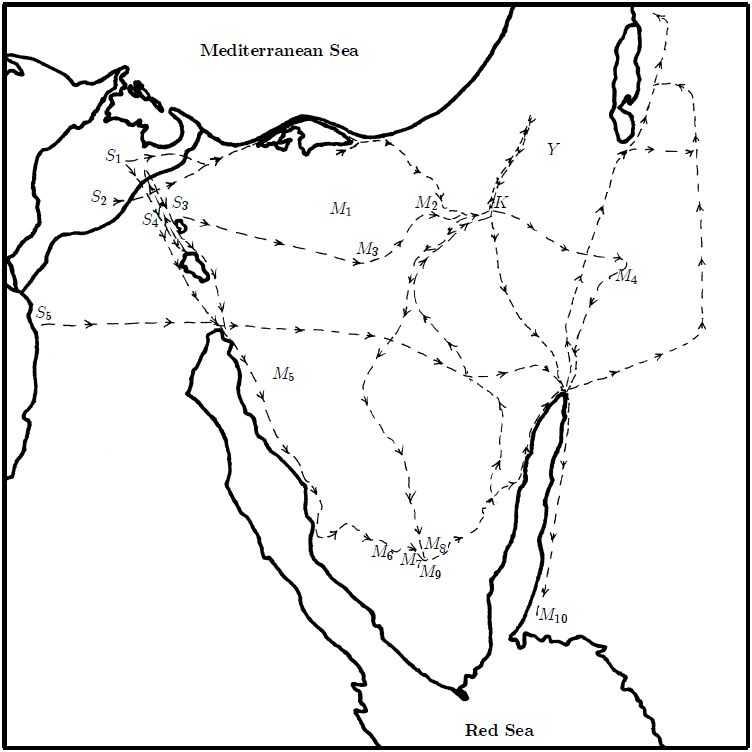 |
The sketch shows four separate proposed routes crossing the Sinai peninsula from Egypt to Palestine with a number of variations on their beginnings and endings. Notice that these routes are not grouped together; rather, they range over the whole length of the peninsula. Observe also that scholars are quite uncertain regarding the starting place; I have labeled the suggested starting points I came across in my quick search S1 through S5. Finally, notice that even points along the route for which substantial Biblical historical and geographical information is given are quite uncertain. I have illustrated this last point by showing ten different mountains (labeled as M1 through M10 on the sketch) which were suggested as candidates for the Biblical Mount Sinai in the same standard Bible resource books mentioned above.
Obviously, there is a great divergence of opinion about the route of the Exodus and the subsequent Wilderness Wandering among modern scholars.
In the present article I will attempt to show a portion of my recent solution to this problem. This may be thought a curious exercise for a Biblical chronologist to undertake—surely the problem of these routes is fundamentally one of Biblical geography, not chronology. Yet, surprising though it may seem, the key to the solution in this case is, in fact, correct Biblical chronology. Rather than belaboring this point by indulging in the negative exercise of showing how incorrect Biblical chronology has caused several generations of scholars to get their Biblical geography pertinent to these routes all mixed up, I will restrict my discussion to showing how the correct solution can be easily ascertained through use of available modern data interpreted within the framework of a sound Biblical chronology.
A New Approach
The Bible tells us that over 600,000 men—not counting women and children—came out of Egypt under the leadership of Moses at the time of the Exodus. There can be no mistake about this number, for it is given in Exodus 12:37; repeated in Exodus 38:26, Numbers 1:46, 2:32, 11:21, and 26:51; and broken down into its component parts by genealogical descent in Numbers chapter 2 and again in Numbers chapter 26.
Given, then, that there were 600,000 men, how many people total should we estimate took part in the Exodus?
It seems reasonable to assume that there were roughly the same number of women as there were men, and we shall probably err on the low side if we assume that there was one child for every woman. Thus, it can be estimated that there were probably in excess of one million eight hundred thousand people who participated in the Exodus! For convenience, I will round this estimate to an even two million.
Now I have a very simple, and—I think—obvious proposal to make: it is impossible for two million people to spend forty years wandering about in a desert and leave no material trace of their presence. I venture to suggest that, were a similar size multitude of families to be led on a camping expedition from Egypt to Palestine today, the trail of discarded soda cans alone would be sufficient to discern their route five thousand years hence.
I do not mean to be entirely facetious by this comparison. The Israelites did not bring along any soda cans, of course, but they would necessarily have brought along numerous pottery vessels—such as "their kneading bowls bound up in the clothes on their shoulders" (Exodus 12:34). Of the hundreds of thousands of such vessels which must have been brought along during the Exodus, a small fraction would inevitably get broken one way or the other each day. The fragments of such broken pottery—the shards—would then simply be discarded, leaving an extremely durable and distinct record of the Israelites' presence.
I say the discarded shards would leave a durable record because fired pottery shards are essentially indestructible when left to the elements. They do not rust or decay, and as they have no intrinsic economic or utilitarian value they are likely to be left indefinitely lying where they were initially discarded. I say the discarded shards would leave a distinct record because archaeology has shown unequivocally that the composition, design, and decoration of pottery vessels changes from one culture to another and from one time period to another. Pottery shards can therefore be used with a very high degree of precision to identify when and by whom the pottery vessels from which they came were originally made.
Thus, if the style of pottery used by the Israelites at the time of the Exodus were known, there is every reason to believe a trained archaeologist would quite literally be able to follow the trail of their discarded shards across the Sinai desert from encampment to encampment even today.
The Pottery of the Exodus
The difficulty, of course, is in identifying the style of pottery used by the Israelites at the time of the Exodus. This is not an intrinsic difficulty—it has become a difficulty only because such an identification depends intimately upon the absolute chronology of the Exodus, and, as you probably know by now, the chronology of the Exodus is out by a thousand years or more in the standard literature at present. Said simply, if you try to assign pottery of a style that only existed a thousand years after the Exodus to the Israelites at the time of the Exodus you won't get very far. You will not be able to follow the trail the Israelites made across the desert at the time of the Exodus if you are looking for that sort of pottery because the Israelites of the Exodus never used or had even seen that sort of pottery.
Thus, the problem of freeing the route of the Exodus from a mere literary exercise to one in which hard physical data find their legitimate role depends entirely for its solution upon sound Biblical chronology.
I have just said that identifying the style of pottery used by the Israelites at the time of the Exodus—let us call it "Exodus pottery" from now on—is not intrinsically difficult if your Biblical chronology is sound. Let me demonstrate.
To get from Egypt to Palestine on foot one has to cross the Sinai peninsula. Such a journey cannot be made in a single day. The Bible tells us that the Israelites set up temporary camps along the way. Thus, the first signature of Exodus pottery (recall: Exodus pottery means the pottery actually used by the Israelites at the time of the Exodus) is that it will be found in ancient campsites in the Sinai peninsula.
The Israelites comprised a distinct culture residing in the northeastern delta region of Egypt during their enslavement. They can be expected to have made and utilized their own distinctive pottery while in Egypt, and to have continued doing so on their way to Palestine and once they had settled there.
When they left Egypt the pottery they carried with them would be expected to be predominantly of their own manufacture, but not exclusively so. They had been living in Egypt and among the Egyptians and so there is every reason to suppose they would initially possess some fraction of Egyptian pottery as well. Thus, the second signature of Exodus pottery is that its shards should be predominantly of a characteristic Palestinian pottery style, but (at least initially) with an admixture of characteristic contemporary Egyptian pottery.
Now let us add in chronological constraints. We can use our knowledge of when the Exodus happened to specify the style of Egyptian pottery shards and the style of Palestinian pottery shards comprising Exodus pottery.
One of the immediate results of the missing millennium thesis presented in my book, A New Approach to the Chronology of Biblical History from Abraham to Samuel,[3] was the correlation of the collapse of the Old Kingdom of Egypt with the Biblical account of the Exodus. Indeed, I argued, we must regard the collapse of the Old Kingdom as being due to: the trauma experienced by the nation of Egypt in the plagues which led up to the Exodus; the loss of wealth and slave labor force which accompanied it; and the loss of the Pharaoh and his army which followed on its heels. Therefore, the third signature of Exodus pottery is that the Egyptian shards must necessarily be of a style which was in use in Egypt at the time of the Exodus, i.e., at the end of the Old Kingdom and beginning of the First Intermediate Period.
A further immediate consequence of the missing millennium thesis was the correlation of the collapse of the Early Bronze Age III urban culture in Palestine with the Conquest under Joshua. I showed that the period which followed this collapse—variously dubbed Early Bronze Age IV, Middle Bronze Age I, or Intermediate Bronze Age—must correspond to the settlement of Israel in Palestine. Thus, the fourth and final signature of Exodus pottery is that the Palestinian shards must necessarily be of an Early Bronze Age IV style.
The Pottery Data
Having specified these four signatures of Exodus pottery, it is now only necessary to inquire whether such pottery has ever been found. These signatures are sufficiently time and space specific to justify the assertion that the discovery of Exodus pottery in quantity at any site almost certainly marks that site as part of the route of the Exodus.
As it happens, one of the things which archaeologists do is to explore large areas by walking or riding across the ground, cataloging the location and type of pottery shards they find lying about on the surface. These sorts of studies are called surface surveys. They help the archaeologists to know where people were living at various periods in the past.
Significant surface surveys were conducted in the Sinai peninsula in the sixties and seventies. Fortunately—for our purpose of finding the route of the Exodus, at least—the Sinai peninsula has, since very ancient times, not been regarded as a very nice place to live, so the catalog of pottery shard finds for this region is relatively small and uncomplicated.[4]
The most important surface survey for our present discussion was conducted by Eliezer D. Oren from 1972 to 1982 on behalf of the Ben Gurion University. Oren's research resulted in the following discovery, succinctly summarized by archaeologist Ram Gophna:[5]
… Egyptian pottery has been identified among the finds of the North Sinai survey conducted by the Ben Gurion University in the seventies (led by E. D. Oren). The Egyptian shards were found together with pottery typical of the Intermediate Bronze Age [i.e., Early Bronze Age IV] in Israel at 45 campsites of the period discovered during the survey.
This quote immediately displays three of our four Exodus pottery signatures. It informs us of the discovery of:
pottery from Sinai campsites,
mixed Palestinian and contemporary Egyptian shards, and
an Early Bronze Age IV date for the Palestinian pottery.
The remaining signature regards the time period for the Egyptian pottery. Oren and Yekutieli wrote regarding the Egyptian shards that they were "typical of Upper and Middle Egypt sites of the 4th and 6th dynasties and of the beginning of the First Intermediate Period."[6] Oren and Yekutieli went on to discuss the pottery of their campsites in the larger context of similar pottery from Egypt and Palestine and narrowed the date of the campsites they had discovered "to the beginning of the Middle Bronze I period [our Early Bronze IV], i.e., to the period of time that in Egypt coincides with the end of the sixth dynasty [i.e., end of the Old Kingdom] and the beginning of the First Intermediate Period …"[7] This fulfills the fourth signature of Exodus pottery precisely.
Exodus pottery has, therefore, been found (it was found several decades ago, in fact) and there is every reason to believe that the campsites in which it was found are campsites which were made by the Israelites at the time of the Exodus.
On to Mount Sinai
I do not have space to discuss these campsites any further here. I plan to return to them next issue. Let me just state for now that they seem to clear up the route of the Exodus completely, up to and including the location of the "Red Sea" crossing.
I want, rather, to skip ahead and propose a new location for Mount Sinai. Having found, as I believe, the pottery trail of the Exodus, it is possible to follow this trail wherever it may lead, and one of the first places it must lead soon after the Exodus, according to the Bible, is Mount Sinai.
I have shown ten mountains in Figure 1 which various scholars have proposed for the Biblical Mount Sinai. As it turns out, the Exodus pottery trail leads to a totally (to the best of my knowledge) unanticipated mountain. Today it is called Mount Yeroham. I have labeled its position with a Y in Figure 1.
I propose that Mount Yeroham is the Biblical Mount Sinai. This proposal rests on more than just the fact that the pottery which has been found there corresponds to the pottery of Oren's campsites. It is this fact in concert with the archaeology of the site which seems so completely persuasive.
To appreciate the archaeology, however, it is necessary to have a clear picture of the Israelites' stay at Sinai as recorded in the Bible. First, recall that they camped at Sinai for very close to a year.[8] Second, remember that we are talking about a very large number of people—two million or more as discussed above. Third, recall the following incident which took place while they were camped at Sinai:
Now Mount Sinai was all in smoke because the Lord descended upon it in fire; and its smoke ascended like the smoke of a furnace, and the whole mountain quaked violently. (Exodus 19:18; NASB)
Fourth, and finally, recall that Moses built an alter with twelve pillars there.
Then he [Moses] arose early in the morning, and built an altar at the foot of [literally, under] the mountain with twelve pillars for the twelve tribes of Israel. (Exodus 24:4; NASB)
The Archaeology at Yeroham
Of all of the sites which I have been able to identify where Exodus pottery has been found, the site of Yeroham is unique in two ways. First is its size. Thomas L. Thompson has described the site as "extremely large by Bronze Age standards."[9] In fact, it covers about 1,250 acres. Such a size is mandatory for the Israelites to have stayed there for any length of time—1,250 acres sounds like a lot, but when it is divided among two million people the result is only twenty-seven square feet per person.
Second, it is the only site of this type which has, so far, yielded more than a single occupation stratum. At Mount Yeroham alone, two separate levels of occupation were identified. I will return to this very important archaeological observation shortly.
Here is a brief overview of the site written by Moshe Kochavi, one of its earliest excavators:[10]
Ancient remains dating to the Intermediate Bronze Age (Middle Bronze Age I) [our Early Bronze Age IV] are located in the Negev desert on the northeastern spur of Mount Yeroham … The site was first discovered and described by B. Rothenberg. It extends over an area of about 5 sq km [5 square kilometers] and includes a narrow ridge of about 1 a. [1 acre] that contains a cluster of densely built structures and several tumuli [man made mounds of rocks over graves] surrounded by a stone wall. Near this main settlement, on another spur, was a bamah (high place), consisting of a rock altar surrounded by a stone wall. About eighty tumuli were observed on another spur. Other tumuli and isolated structures are dispersed throughout the site, mainly on the saddle between the bamah and the mountain ridge.
The bamah corresponds readily to the altar which Moses built. In particular, the twelve stone pillars which Moses erected appear to be evidenced still today by the sockets in which they once stood.
The bamah is merely a rock cliff, jutting out above the Yeroham Basin. At the top of the cliff is a leveled area with twelve cupmarks of various sizes.[11]
Now let us turn to the question of why there would be two occupation layers at this site alone. I suggest that Exodus 19:18, quoted above, provides the answer here; the Israelites' first settlement at Yeroham was destroyed by the earthquake which accompanied the Lord's descent upon the mountain. Recall that the text says "the whole mountain quaked violently." The obviously temporary buildings at Yeroham were generally built on bedrock of dry-laid field stones. The roofs were supported by central columns built of drum-shaped stones. An earthquake of any magnitude would quickly bring such buildings down. After the earthquake the Israelites would have had to rebuild their settlement, thus creating two occupation strata at this site.
A layer of ash, underlying walls of buildings in the upper settlement, may[12] give further testimony to this reconstruction of events. Recall that Exodus 19:18 says "Now Mount Sinai was all in smoke because the Lord descended upon it in fire; and its smoke ascended like the smoke of a furnace…" The archaeologist Rudolf Cohen, who excavated at Yeroham in 1973, reported this ash layer as follows:[13]
In the lower level, under the western room's stone floor, the bedrock was covered by a 10-cm-thick layer of ash containing shards from the Middle Bronze Age I [our Early Bronze Age IV]. The burnt layer also extends beneath this room's eastern wall. A similar burnt layer was observed in the western corner of the eastern room, extending under the wall.
The tumuli may also support this reconstruction. Moshe Kochavi reported his observations of these as follows:[14]
Two types of tumuli were found: the first is 7 to 8 m [meter] in diameter, rather low, and filled with stones; the second is only 4 to 5 m in diameter but is at least 1 m high. The tumuli erected above the ruins of level II belong exclusively of the second type, whereas the majority on the ridge belong to the first type. Tumuli of the first [low, large diameter] type have therefore been attributed to level II [the earlier level] and those of the second type [high, smaller diameter] to level I [the later level].
Kochavi provided no interpretation of these observations, but an interpretation is readily suggested by the Biblical text. There is no apparent reason why the Israelites would build their tumuli differently in the two occupation levels. Rather, I suggest, the tumuli were only built in one style: the high compact style associated with the later level. However, the tumuli of the earlier level experienced the earthquake. The strong suggestion is that it was the shaking of the mountain which flattened and spread them out.
Rephidim
One final observation pertinent to this matter of the identification of Mount Sinai seems appropriate here.
The Biblical text tells us that the Israelites camped at Rephidim immediately before coming to Sinai.[15] Since they were coming from the general direction of Egypt, we would expect Rephidim to be somewhere to the west of Sinai, and within a one day journey of it.
In fact, there is another settlement where Exodus pottery has been found which is a little less than a day's journey to the southwest of Mount Yeroham. It is known today as Be'er Resisim. The obvious phonetic similarity and other factors cause me to propose that Be'er Resisim is the Biblical Rephidim. I suggest that the combination of evidence from Resisim and Yeroham make a very strong case for their identification with Rephidim and Sinai.
A Closing Twist
A site which is strongly connected with the wilderness wandering which I have not discussed until now is Kadesh-barnea. I illustrated the uncertainty which presently surrounds the route the Israelites took when they left Egypt and journeyed to Palestine in Figure 1 by plotting a variety of suggested starting points, routes across the Sinai, and locations of Mount Sinai. In contrast to these uncertainties, scholars seem pretty confident about the location of Kadeh-barnea—there seems little divergence of opinion on this one site at least. I have labeled their choice K in Figure 1.
Unfortunately, the accepted location of Kadesh-barnea and the location I have just shown for Mount Sinai are in serious conflict. Mount Yeroham is but a day and a half from the accepted location of Kadesh-barnea, while Deuteronomy 1:2 is quite clear that "It is eleven days' journey from Horeb [i.e., Sinai] by the way of Mount Seir to Kadesh-barnea."
But that is another long story, and there is insufficient space to embark upon it here. Perhaps I will have opportunity to show you where I believe Kadesh-barnea is really located in another issue in the near future. ◇
Biblical Chronology 101
I would like to attempt to give you a brief summary of the current state of Biblical chronology, as I see it, in our class this issue. I feel that such a summary is necessary to orient you, the student, in this discipline at present, and to enable you to separate between what is known and what is not known. The recent rapid pace of progress in this discipline makes such a summary seem all the more necessary, and such an undertaking seems appropriate in this, the final class session of 1995.
State of the Subject
The present state of affairs is most easily grasped when depicted on a time chart. I have constructed Figure 2 for this purpose. Please note, before I begin to discuss the meaning of this chart, that the time scale given in the date column on the left is divided into 500 year segments, and that it extends from just before 5000 B.C. to the present.
Figure 2: The state of the field of Biblical chronology at present.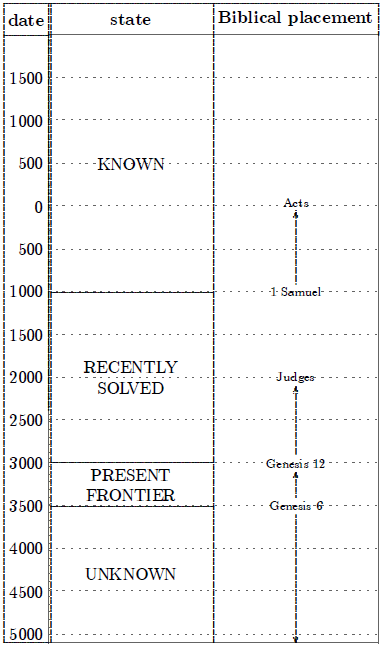 |
The state column shows four distinct "state of affairs" regions. I will discuss each of these under their own heading below. I have placed the boundaries between these regions at the nearest even 500 years for the sake of simplicity of presentation and ease of recall. In actual practice these boundaries are not sharp as drawn—there is in reality some degree of gradation from one region to the next.
The Biblical placement column provides a rough alignment of the Biblical historical narrative with these four regions.
Known
I have labeled the first region "KNOWN." By this label I do not mean to imply that there are no interesting chronological puzzles in this region, of course. For example, the tantalizing problem of the exact year of the birth of Christ is located here.
By the label "KNOWN" I intend to portray only the concept of basic harmony at reasonable precision between the chronology of Scripture and extra-Biblical chronologies in this time period. The hallmark of chronological puzzles in this region is the minuteness of the uncertainty involved—one is usually quibbling over plus or minus a year or two. Modern resource books such as Bible dictionaries and encyclopedias generally provide reliable chronologies and summaries of problems for this time period.
Recently Solved
I have labeled the region from 1000 B.C. to 3000 B.C. "RECENTLY SOLVED." Harmonization of Biblical and secular chronologies in this region only became possible a few years ago. This came about as the result of the realization that one thousand years had accidentally been dropped from traditional Biblical chronological reckoning just prior to 1000 B.C.[16]
Biblical chronological research has been very exciting and rewarding in this region for the past several years, with no sign of the pace of new discovery slackening at present. As a consequence of the rapid pace of progress, even modern Bible resource materials (e.g., textbooks, dictionaries, and encyclopedias) are seriously in error in much of their discussion of this and earlier time periods.
Unfortunately, the insertion of a full millennium in any established chronology is an intrinsically radical process relative to entrenched traditional views. As a result, rapid dissemination of these new discoveries in Biblical chronology has been inhibited and the vast majority of scholars remain totally uninformed regarding them to the present time.
Present Frontier
The period of time from Abraham back to Noah is the present frontier of Biblical chronology research. This period is dominated by two events Biblically: the Dispersion from Babel and Noah's Flood. Significant progress has recently been made in aligning these Biblical events with secular counterparts from archaeology.[17] The present rate of discovery suggests that this region will not remain the frontier of Biblical chronology for very long.
Accurate conceptual models of the Dispersion and the Flood are the greatest needs in this region at present, and they are thus the current targets of much research effort. Biblical exegetes have, in recent centuries, developed conceptual models of the Flood ranging from a mild local inundation to an earth-shattering tectonic upheaval. When actual field data are synchronized with the Biblical text using sound Biblical and secular chronological controls, both of these extremes appear to be eliminated at present. Only further research will reveal where, in between, the truth actually lies.
Unknown
The time period prior to about 3500 B.C. must be regarded as essentially unknown at present. By this I mean that no completely satisfactory means of harmonizing available Biblical and extra-Biblical data in this region has yet been found. However, as I mentioned last issue, there is every reason to believe a proper synthesis of the data in this region will eventually be discovered.
Having stated this, I need to emphasize that there seem to me to be two prerequisites to discovery of this long-sought proper synthesis. First is the need for a thorough familiarity with, and respect for, all of the Biblical and secular data bearing on the problem. Second is the need for an accurate picture of the history of the later periods of time—specifically the Flood and Dispersion. It seems to me to be obvious folly to suppose we shall somehow be able to successfully integrate data from the supernatural dawn of Creation before we have learned to properly handle the comparatively tame data from the Flood.
The Future
Predicting the future is a pretty precarious activity, so I will merely suggest that it should be fun to see what new discoveries 1996 will bring. ◇
Research in Progress
My main research thrust these past several months has been in relation to the route the Israelites took from Egypt to Palestine. (See the lead article this issue.) The determination of this route enables much of the historical narrative contained in the Biblical books of Exodus through Deuteronomy to be properly harmonized with a great deal of Biblical archaeology data for the first time. It also sheds new light on several long-standing Biblical geography problems. Continued work on this topic seems necessary and appropriate at present, so I expect to carry on with it for the next several months. ◇
The Biblical Chronologist is a bimonthly subscription newsletter about Biblical chronology. It is written and edited by Gerald E. Aardsma, a Ph.D. scientist (nuclear physics) with special background in radioisotopic dating methods such as radiocarbon. The Biblical Chronologist has a threefold purpose: to encourage, enrich, and strengthen the faith of conservative Christians through instruction in Biblical chronology, to foster informed, up-to-date, scholarly research in this vital field within the conservative Christian community, and to communicate current developments and discoveries in Biblical Chronology in an easily understood manner.
The Biblical Chronologist (ISSN 1081-762X) is published six times a year by Aardsma Research & Publishing, 412 N. Mulberry, Loda, IL 60948-9651. Editor and Writer: Gerald E. Aardsma, Ph.D.
Subscription rate: $18.00 per year (six issues) to US address; $19.00 per year to Canada or Mexico; $26.00 per year to all other countries. US funds only. An introductory packet containing the first three issues of volume 1 and a subscription order form is available for $9.95 US regardless of destination address. Send check or money order and request the "Intro Pack."
Copyright © 1995 by Aardsma Research & Publishing. Photocopying or reproduction strictly prohibited without written permission from the publisher. |
Footnotes
^ The Archaeology of Ancient Israel, ed. Amnon Ben-Tor (New Haven: Yale University Press, 1992).
^ See, for example, Numbers 33:1-49.
^ Gerald E. Aardsma, A New Approach to the Chronology of Biblical History from Abraham to Samuel, 2nd ed. (Loda IL: Aardsma Research and Publishing, 1993).
^ See, for example, Thomas L. Thompson, The Settlement of Sinai and the Negev in the Bronze Age (Wiesbaden: Dr. Ludwig Reichert Verlag, 1975).
^ Ram Gophna, "The Intermediate Bronze Age," The Archaeology of Ancient Israel, ed. Amnon Ben-Tor (New Haven: Yale University Press, 1992), 127.
^ E. D. Oren and Y. Yekutieli, "North Sinai During the MB I Period—Pastoral Nomadism and Sedentary Settlement," Eretz-Israel 21 (1990): 11. (English translation provided by Marganit Weinberger-Rotman.)
^ E. D. Oren and Y. Yekutieli, "North Sinai During the MB I Period—Pastoral Nomadism and Sedentary Settlement," Eretz-Israel 21 (1990): 16. (English translation provided by Marganit Weinberger-Rotman.) Oren and Yekutieli give absolute dates in the range of 2130-2250 B.C. for this period of time. These dates are based on the historical chronology of Egypt, which has now been shown to be in error by about 300 years at this early period by both radiocarbon dating and Biblical chronology. (See: Gerald E. Aardsma, A New Approach to the Chronology of Biblical History from Abraham to Samuel, 2nd ed. (Loda IL: Aardsma Research and Publishing, 1993), 60.) The correct date for the end of the Old Kingdom, and for these campsites is ca. 2450 B.C.
^ See Exodus 19:1 and Numbers 10:11-12.
^ Thomas L. Thompson, The Settlement of Sinai and the Negev in the Bronze Age (Wiesbaden: Dr. Ludwig Reichert Verlag, 1975), 21.
^ Moshe Kochavi, "Mount Yeroham," The New Encyclopedia of Archaeological Excavations in the Holy Land, vol. 4, ed. Ephraim Stern (New York: Simon & Schuster, 1993), 1506.
^ Moshe Kochavi, "Mount Yeroham," The New Encyclopedia of Archaeological Excavations in the Holy Land, vol. 4, ed. Ephraim Stern (New York: Simon & Schuster, 1993), 1507.
^ I say "may" because I am unable to rule out other possible explanations for this ash layer. For example, a pottery kiln was located in the settlement, and it is possible for the ash and shards to be due to it. I am unable to determine whether the kiln was located close enough to this ash layer to serve as a reasonable potential source for it from the published reports of the site available to me so far.
^ Moshe Kochavi, "Mount Yeroham," The New Encyclopedia of Archaeological Excavations in the Holy Land, vol. 4, ed. Ephraim Stern (New York: Simon & Schuster, 1993), 1509.
^ Moshe Kochavi, "Mount Yeroham," The New Encyclopedia of Archaeological Excavations in the Holy Land, vol. 4, ed. Ephraim Stern (New York: Simon & Schuster, 1993), 1507.
^ Exodus 19:1–2.
^ Gerald E. Aardsma, A New Approach to the Chronology of Biblical History from Abraham to Samuel, 2nd ed. (Loda IL: Aardsma Research and Publishing, 1993.)
^ Gerald E. Aardsma, "Research in Progress," The Biblical Chronologist 1.4 (July/August 1995): 6–10.


